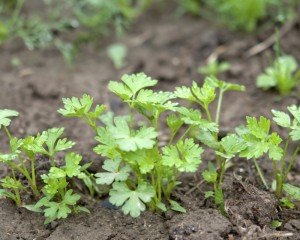Hello friends of Steemianos, today I want to talk to you about the cultivation of parsley in the gardens; but before I will make a brief description of this plant. The parsley, Petroselinum crispum, is a biannual plant of the Apiaceae family and is native to the Mediterranean, in Europe and is now widespread throughout the world, due to its great importance in gastronomy. In addition to being a widely used plant in the kitchen, parsley possesses many medicinal properties.

Source
Characteristics of the parsley plant
There are essentially two types of parsley, the smooth or common leaf (Petroselinum sativum latifolium), which is characterized by having a strong flavor and aroma, and is commonly used in Mediterranean cuisine; and curly leaf parsley or Chinese parsley (Petroselinum sativum crispum), which is sweeter and softer.
The parsley is a plant of erect bearing and can measure between 60 centimeters to 1 meter of height, with asurcados stems and ascending branches. It is grown for its leaves, which are used as a seasoning. It is a plant whose propagation is by seeds.
Parsley is a biannual plant its root is fusiform and whitish. The thickness depends on the variety that you want to take advantage of. In its first year of vegetation, it emits very petiolate radical leaves that are arranged in a rosette. The limbus can be double or triple pinnacled, and can be smooth or curled. They are usually dark green.
In the second year the floral stem develops that can reach 80 cm in height. It gives rise to an umbel-shaped inflorescence formed by small greenish-yellow or reddish flowers. The fructification is in small achenes of grayish color. the seeds under normal conditions have a germination power of approximately two years.
Steps for planting parsley in flower beds
Seeds can be purchased at businesses that sell agricultural products.
Once you have the seeds, you must prepare the land where you have decided to plant the parsley.
You must remove the soil well, to a depth of 20 centimeters and add a substrate based on compost and earthworm humus.
Once the place where you plan to plant is prepared, first place the tiny seeds of parsley in a container with water, which will remain soaking for a period of 24 hours, to facilitate germination and then proceed to sow.
The distribution of the seeds is done in rows, placing the seeds in the soil at a depth of 1 cm. at a distance of 20 centimeters between them and 30 centimeters between each row.
The germination of parsley seeds takes approximately 15 to 20 days after sowing; You can also make nurseries to later transplant. These can be done in germination trays. The weight of 100 seeds weighs 1.4 gr, with this data they can calculate the amount of plants they need.

Source
Once the plants are germinated, water in the morning and in the afternoon; The most recommended irrigation system is the sprinkler system.

SourceThe plant must be at a point where it receives about 5 hours of light a day. A defect or lack of light would cause some leaves with a light green tone and would result in less development of the plant, which is less leafy. It can also adapt to semi-shaded areas
In terms of pests and diseases of the parsley plant, the most common are fungi and attacks of snails and slugs. It is important to spray plants preventively to prevent different pests from invading the crop; It is advisable to carry out permanent monitoring in the plants.
The leaves of parsley can be harvested with the use of scissors.
From the second year the plant will bloom and we will be able to obtain our own seeds once the flowers dry. So you can create your own seed bank of aromatic plants and you can exchange them and share them with more people.
Sources: https://www.ecoagricultor.com/consejos-para-plantar-perejil/
Dear friend, you do not appear to be following @wafrica. Follow @wafrica to get a valuable upvote on your quality post!